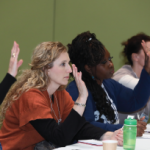 Pain is processed in the brain, but it isn’t “all in your head,” according to recent research, which found a combined physical, psychological and social connection to how a person experiences pain.1
Pain is processed in the brain, but it isn’t “all in your head,” according to recent research, which found a combined physical, psychological and social connection to how a person experiences pain.1
Children living with chronic conditions, such as juvenile idiopathic arthritis, likely experience pain differently from adults. Their brains are still developing. Example: In a study of pain experienced by young patients with polyarticular arthritis, 76% reported frequent pain despite the successful suppression of inflammation with methotrexate, tumor necrosis factor alpha inhibitors or both.2
Added to this experience are the social experiences of children and adolescents, which further influence how their pain is processed. Recognizing the multi-faceted aspects of pediatric pain, pediatric care providers working in pain management, psychology and physical and occupational therapy are collaborating to apply a bio-psycho-social understanding of pain. This approach is an interdisciplinary model for pediatric pain management, according to Eugene Kim, MD, chief of the Division of Pain Medicine, Children’s Hospital Los Angeles, and Alvina Rosales, PhD, clinical psychologist at the Division of Pain Medicine, Children’s Hospital Los Angeles.
The Bio-Psycho-Social Pain Management Model
The bio-psycho-social model of pain illustrates how complex the pain experience is. Dr. Kim says, “Pain is a physical experience that may result from direct trauma to the body, and/or from psychological stress or trauma. Not every person feels injuries and trauma the same way.”
Example: Psychologically, if a person sustained a paper cut while holding a winning lottery ticket, their pain would be experienced differently than if they sustained the same paper cut while holding an overdue bill.
A person’s surroundings may also play a role in how they experience pain. “Socially, a teenager may experience pain differently when with his friends vs. at home,” he says.
To treat pain, Dr. Kim says the goal is to “assess and address all of these different areas in order to make the biggest impact.”
An Interdisciplinary Approach to Pediatric Pain
For children and adolescents with chronic conditions, Dr. Kim works closely with a team of clinical psychologists, including Dr. Rosales, and physical and occupational therapists to address a patient’s pain. Together, each interdisciplinary role within the treatment represents the bio-psycho-social model of pain management.
“Each team member uses his or her area of expertise to affect the patient in different, but highly complementary ways to improve their functioning,” Dr. Rosales says. Example: Dr. Kim’s treatment may focus on pharmacological approaches to alleviate pain, enabling patients to tolerate physical and occupational therapies. In turn, occupational and physical therapists work more effectively on restoring function and strength within the targeted areas.
“Psychologists aim to identify and address psychosocial factors that can worsen pain severity and daily functioning, such as chronic stress or trauma, social anxiety and depression,” Dr. Rosales says. “It is important to recognize that the coordination of these disciplines is key to treatment success.”
Successful Collaboration
Care conferences are one important collaborative strategy Dr. Kim, Dr. Rosales and their team members apply to treat pediatric pain through this model. A care conference provides a way for all team members to come together and openly discuss a patient’s progress, areas of improvement and concerns. This meeting helps create an individualized program plan for the patient that will set them up for success, Dr. Rosales notes.
“Take a patient who reports no discomfort to a physical therapist because they may fear they are perceived as weak or non-compliant. But [that patient] may then report to the physician or psychologist that they are in fact experiencing pain. Similarly, the physical therapist may see that the patient is struggling in a particular area that may prompt different management by the physician or psychologist,” she says.
Carina Stanton is a freelance science journalist based in Denver.
References
- Gatchel RJ, Howard KJ. The biopsychosocial approach. Practical Pain Management. 2018 Apr;8(4).
- Schanberg LE, Anthony KK, Gil KM, et al. Daily pain and symptoms in children with polyarticular arthritis. Arthritis Rheum. 2003 May;48(5):1390–1397.
Learn More
Eugene Kim, MD, Alvina Rosales, PhD, and occupational therapist Talitha Cox are sharing their perspectives on the interdisciplinary roles of the physician, psychologist and occupational therapist in applying the bio-psycho-social model for pain management during the 2019 ACR/ARP Annual Meeting, Nov. 8–13.


